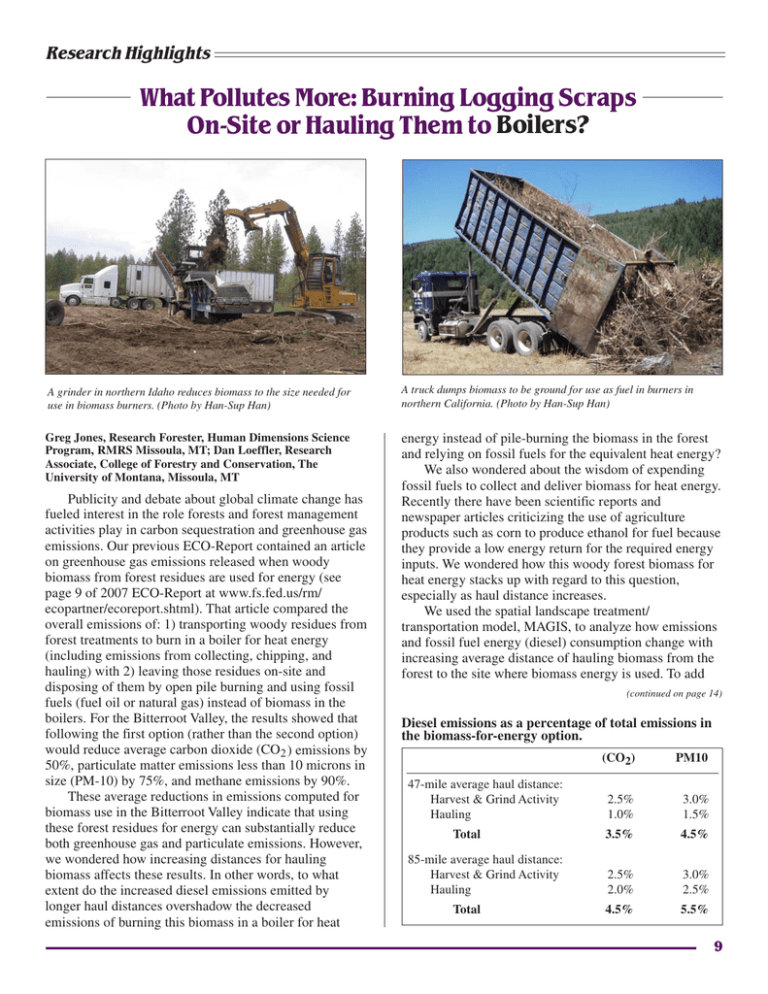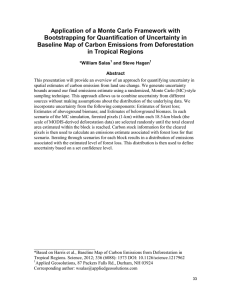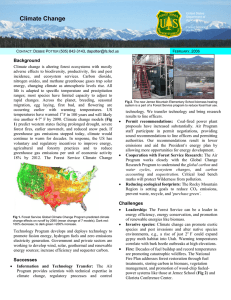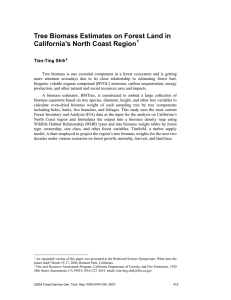What Pollutes More: Burning Logging Scraps On-Site or Hauling Them to Boilers?
advertisement

Research Highlights What Pollutes More: Burning Logging Scraps On-Site or Hauling Them to Boilers? A grinder in northern Idaho reduces biomass to the size needed for use in biomass burners. (Photo by Han-Sup Han) A truck dumps biomass to be ground for use as fuel in burners in northern California. (Photo by Han-Sup Han) Greg Jones, Research Forester, Human Dimensions Science Program, RMRS Missoula, MT; Dan Loeffler, Research Associate, College of Forestry and Conservation, The University of Montana, Missoula, MT energy instead of pile-burning the biomass in the forest and relying on fossil fuels for the equivalent heat energy? We also wondered about the wisdom of expending fossil fuels to collect and deliver biomass for heat energy. Recently there have been scientific reports and newspaper articles criticizing the use of agriculture products such as corn to produce ethanol for fuel because they provide a low energy return for the required energy inputs. We wondered how this woody forest biomass for heat energy stacks up with regard to this question, especially as haul distance increases. We used the spatial landscape treatment/ transportation model, MAGIS, to analyze how emissions and fossil fuel energy (diesel) consumption change with increasing average distance of hauling biomass from the forest to the site where biomass energy is used. To add Publicity and debate about global climate change has fueled interest in the role forests and forest management activities play in carbon sequestration and greenhouse gas emissions. Our previous ECO-Report contained an article on greenhouse gas emissions released when woody biomass from forest residues are used for energy (see page 9 of 2007 ECO-Report at www.fs.fed.us/rm/ ecopartner/ecoreport.shtml). That article compared the overall emissions of: 1) transporting woody residues from forest treatments to burn in a boiler for heat energy (including emissions from collecting, chipping, and hauling) with 2) leaving those residues on-site and disposing of them by open pile burning and using fossil fuels (fuel oil or natural gas) instead of biomass in the boilers. For the Bitterroot Valley, the results showed that following the first option (rather than the second option) would reduce average carbon dioxide (CO2 ) emissions by 50%, particulate matter emissions less than 10 microns in size (PM-10) by 75%, and methane emissions by 90%. These average reductions in emissions computed for biomass use in the Bitterroot Valley indicate that using these forest residues for energy can substantially reduce both greenhouse gas and particulate emissions. However, we wondered how increasing distances for hauling biomass affects these results. In other words, to what extent do the increased diesel emissions emitted by longer haul distances overshadow the decreased emissions of burning this biomass in a boiler for heat (continued on page 14) Diesel emissions as a percentage of total emissions in the biomass-for-energy option. 47-mile average haul distance: Harvest & Grind Activity Hauling Total 85-mile average haul distance: Harvest & Grind Activity Hauling Total (CO2) PM10 2.5% 1.0% 3.0% 1.5% 3.5% 4.5% 2.5% 2.0% 3.0% 2.5% 4.5% 5.5% 9 Getting the Word Out Glossary – “What Do You Mean By That?” Despite our efforts to write ECO-Report articles in “jargon-free” language, we still have to use terminology unfamiliar to some readers. Should you not recognize a term in ECOReport, this glossary may help. If you don’t find the word here, visit BEMRP’s Glossary web page at http://www.fs.fed.us/rm/ecopartner. Remember some definitions change over time as new information develops. Periodically, we revise our web glossary page to reflect these changes. BIOCONTROL—The use of living organisms, such as predators, parasites, and pathogens, to control weeds, pest insects, or diseases. FLAME LENGTH—The distance between the flame tip and the midpoint of the flame depth at the base of the flame (generally the ground surface); an indicator of fire intensity. FLUME—A flume is an instream structure used to measure the rate of flow. Flumes can also be designed to collect water quality data and other measurements such as temperature. Burning or Hauling? . . . (from page 9) reality to these computations, we assumed that the forest biomass is hauled from various locations in the Bitterroot Valley to the paper mill near Frenchtown, which has a boiler for generating energy from woody biomass. We used the same published diesel consumption and emission factors used in the previously reported results. Diesel consumption and emission amounts are based on the round trip, because one must first get the empty truck to the forest site where the biomass is located. Our analysis found that when forest residue biomass is used for energy on only the northern portion of the Valley, the average haul distance is 47 miles, increasing to an average of 85 miles when utilization is extended to the entire valley. At the 47-mile average distance, diesel CO2 and PM10 emissions from hauling each represent only about 1% and 1.5%, respectively, of the total emissions for the biomass-for-energy option (see table). These increase to about 2% for CO2 and 2.5% for PM10 of the total emissions at the 85-mile average haul distance. This means that reduction in emissions associated with using forest residues for heat energy is little affected even at relatively long haul distances. Emissions from harvest and grinding represent a slightly larger portion of the total emissions, around 2.5% for CO2 and 3% for PM10. Summing the two components for CO2 , total diesel emissions represent 3.5% at the 47- 14 SNOTEL—A SNOTEL is an automated station that collects information on snowpack and climate. They are usually set up in areas difficult to access in the winter. SNOTEL sites record data on snow water content, precipitation, and sometimes other information. The acronym stands for SNOw TELemetry. Anyone with internet access can get readouts from SNOTEL sites at http:// www.wcc.nrcs.usda.gov/snotel/. TRAJECTORY—A trajectory is a path that a moving object follows. In forest ecology terms, it is the developmental pathway of the forest ecosystem over time. mile average, increasing to 4.5% at the 85-mile average haul distance. Total PM10 emissions from diesel range from 4.5% to 5.5% of the total biomass-for-energy emissions, indicating the difference in emissions is minimal over this range in haul distance. What about the amount of fossil fuel (diesel) energy needed to harvest, grind, and haul the forest residue biomass to produce the heat energy? At the average haul distances we used, diesel energy consumption represents 4.7% to 5.7% of the total biomass energy produced. That means at the shorter haul distance about 21 units of biomass energy are produced for each unit of diesel energy used to get it. At the longer distance this drops to 17 units of biomass energy for each unit of diesel energy. To determine if this is a good return of energy for the energy expended, we can use the breakeven point, where it takes one unit of energy for each unit produced. Getting a return of 17 to 21 units of energy for 1 unit of energy expended is clearly well above the breakeven point. We thought it would be interesting to compare this with uses of other types of biomass for producing other forms of energy. Researchers at the Argonne National Laboratory have published that 1.35 units of energy of ethanol made from corn are produced for each unit of fossil fuel energy used. Compared to ethanol, 17 to 21 units of biomass heat energy for 1 unit of diesel energy used to produce it is a good energy return. However, we recognize that using ethanol for fuel and burning biomass for direct heat are not substitutes for each other.




